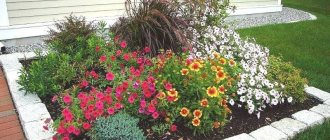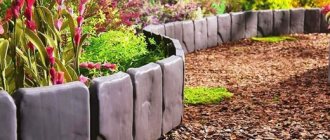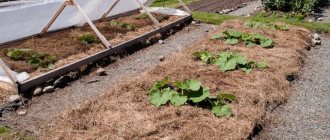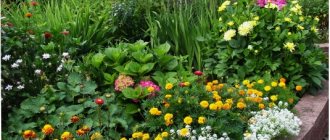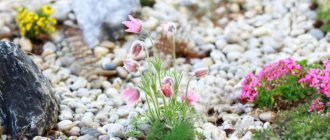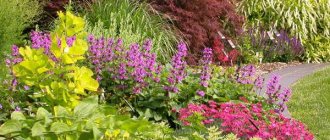Perennials are an excellent basis for flower beds
Gardeners are very fond of perennial plants. They are great for organizing flower beds. The following advantages of perennials compared to annual plants can be identified:
- Lifespan of a plant. During the winter, only the top of the plant dies off, but the roots can live up to six or even more years.
- Easy to breed. To organize flower beds, you can use shoots, seeds and roots of plants.
- Medicinal properties. Many perennials have a healing effect.
Rules for organizing flower beds
With the right choice of perennial plants, you get a flowerbed of continuous flowering: some species will begin to bloom, while others will immediately bloom.

Before planning the location of the flower garden, it is worth deciding where the paths and beds will be placed.
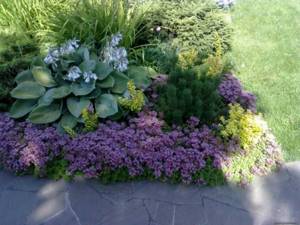
When choosing plants for beautiful perennial flower beds, you need to consider:
What to plant - onions or perennial flowers?
Not everything in the garden should be for the belly, you need to leave room for “beauty” - just for the soul. A flowerbed of continuous flowering perennials can easily decorate even the most inconspicuous area, giving it a unique charm. Roses, geraniums, carnations, poppies and asters will grow in the same place season after season without requiring special attention.
A question that every novice gardener must understand is the choice of plants for a perennial flower garden. From practical experience, the first flowerbed should be made small and planted with unpretentious flowers that grow well under the bright sun.
A flowerbed is a bright element of the garden, so there is no point in planting it in the far corner of the site or hiding it under the shade of trees. The optimal solution for creating a perennial flower bed would be a place that is clearly visible from all sides.
Multi-level flower beds (with tall plants in the background and short ones in the foreground) are usually placed near the walls of a house, a fence or hedge. Whereas in the center of the site, a constantly blooming flowerbed of perennials can either form all sorts of combinations of plants, or be decorated with only one species.

Flowerbeds of perennials in the garden and country house
Soil type
The location on fertile black soil is loved by mallow, bluebell and lupine. If the soil has a lot of sand, clay or sandstone, then it is better to plant valerian, flax and sage.
Yarrow, cornflower and asters grow wonderfully on marshy soils, and carnations, cosmos, phlox and gaillardia grow on excessively dry soils.
Types of compositions
Flowerbeds of different types are made from perennial plants. They are performed in one of two options:
- Regular composition. A geometric pattern is visible, and all the flowers bloom at the same time.
- Irregular composition. Such flower beds are more popular because the plants in them do not bloom at the same time. This allows you to enjoy flowering for a long time.
FLOWER BED SCHEMES FOR EVERY TASTE 'Garden, vegetable garden'
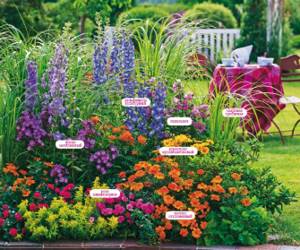
When preparing a composition, it is important to consider the following points:
- A combination of different shades, sizes and shapes of plant leaves. Determine the main colors of your flowerbed, these are usually yellow, red, orange, pink shades. You can choose purple or blue colors as the background.
- Plant care needs: watering, lighting, required space for growth (planting density).
- Flowering period – properly selected plants with a long flowering period will delight you until late autumn.
- Using a border - Without a doubt, edging greatly improves the appearance of the flower bed, so you can use stones, bricks or low-growing plants as the border of the flower bed.
Construction rule -

Geometric flower beds
There are a large number of standard perennial flower bed designs. Regardless of the shape of the flowerbed, bright and tall plants should be planted in the center, medium-sized flowers in the middle, and low-growing ones at the edges.
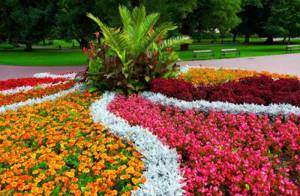
Flowerbeds are usually designed in the shape of one of the following geometric shapes:
- Rectangle. Such flower beds are distinguished by their clarity of shape. By combining flowers, you can make different designs.
- Oval. Combining different types of plants allows you to create fascinating designs in your flowerbed.
- Circle. A round flowerbed in a country house is very popular because this shape makes it easier to care for plants.
- Triangle. Such flower beds are quite rare, but they can be placed where there is not a lot of free space.

Recently, another common option for flower beds is planting plants in boxes up to one meter high. They are more difficult to create, but there will be no problems with weeds and flower care.
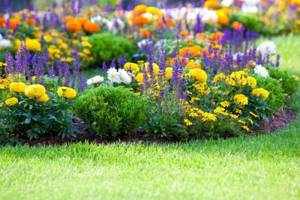
Technical points on how to create a flower garden from continuous flowering perennials.
Let us also dwell on agrotechnical measures when creating a flower garden of continuous flowering. The soil for a flower garden must be prepared carefully, since the main assortment is perennials. Thoroughly dig up the area, freeing it from weeds. Sprinkle mineral fertilizers or wood ash on top and dig well again. Don't plant the plants right away. Even if you are sure that you have selected all the rhizomes of wheatgrass and sow thistle, water the area and let the soil settle a little.
The design of a flower garden of continuous flowering perennials must maintain a certain distance between plants for good growth. So the distance between plants is approximately 15 cm for ground cover perennials and annuals, 15 - 30 cm for short-growing ones, 30 - 40 cm for medium-sized ones (25 - 35 cm high) and 50 cm for tall ones, in some cases 1 m. It is better to plant perennials do in cloudy weather. Start with large plants, distant from the path.
Scheme of a continuous flowering bed for beginners:

Plants with fast, aggressive growth that produce shoots must be limited by digging in plastic containers without a bottom or a special plastic border (available in flower shops).
Plastic containers are preferable to metal ones due to the fact that in winter, when the snow level is low, the roots of the plants in them will not suffer from freezing.
Scheme for planting flowers in a continuous flowering bed:

Types of flower beds by planting density
According to the density of planting, the following flower beds are distinguished:
- Solitaires. Single plants or shrubs with large flowers or leaves are planted at a fairly large distance.
- Discounts. They are strips running along paths, walls or fences.
- Curbs. They look like the edging of a flower bed.
- Parterres. A spacious flower garden combining a lawn, border and ridge.
- Mixborders. Popular with non-professionals. Such flower beds bloom from the beginning of spring until the onset of frost.
- Arrays. They are large flower beds with plants that do not require special care.
- Groups. They are distinguished by their smooth shapes and bright floral spots located on the lawn or area.
- Arabesque. Pebbles and colored stones are used in their design.
- Vases. In this case, the plants are planted in vases or nets similar to baskets.
- Rock garden or rock garden. Similar flower beds of flowering perennials imitate mountainous terrain.
How to select perennials for a continuous flowering bed
The advantages of a mixborder are a wide variety of assortment and the variability of its appearance, lively dynamics. Some plants pass the baton of flowering to others. And if colorful annuals are added to the perennials, then the appearance of the flower garden will also change from year to year. Using annual crops, of course, will add trouble to you: you need to sow them every year and grow seedlings. But what else, besides marigolds, petunias, lobelia and the like, will make your flower garden sparkle with rich colors for so long and make it a flower garden of continuous flowering?
In the mixborder you can also plant indoor geraniums, chlorophytum, and coleus for the summer. In large flower beds, low-growing species and varieties of shrubs are appropriate - Japanese meadowsweet, Thunberg barberry, Cossack juniper and others. Here is the mixborder diagram.

When designing a flower “mixture,” it is important not to overload the flower garden. Plants with small flowers, leaves (monarda, phlox) and annuals will look better planted not one by one, but in groups. Very unusual and beautiful mixborders are obtained if you use herbs to create them.

It’s another matter if the plant grows quickly or the bush itself is tall, with pronounced decorative leaves and an interesting shape. Such plants do not require “company”. They act as soloists, favorites (excellent perennials for a continuous flowering bed - delphinium, lupine, rudbeckia, peony). Here are bright mixborders made from perennials, photo and diagram.

The task of the short “retinue” is to cover the bare stems of the favorites and create a background.
It is beautiful when a flower garden of continuous flowering perennials combines plants with different forms of inflorescences. When plants with chamomile and spherical inflorescences bloom next to plants with spicate inflorescences. For example, lupine inflorescences, elongated like candles, sharply contrast with monarda, and light openwork goldenrod inflorescences will fill the voids and soften sharp transitions. The inflorescences of the spikes are liatris, most types of buzulnik, speedwell, delphinium, loosestrife, and among the annuals - snapdragon, salvia. Alternation of plants with large leaves (bergenia, hosta) and narrow pointed leaves (daylily, iris), alternation with large and small flowers also looks advantageous.
Plants suitable for perennial beds
Below are perennial flowers for the flower bed that look perfect in the garden:
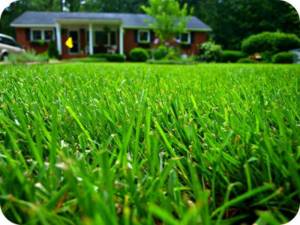
Ornamental grass: review of the best decor options and instructions for using ornamental grass (170 photos)
How to design a flowerbed - instructions, diagrams, types and options for proper placement of a flowerbed (140 photos)
- DIY flower beds - 180 photos of unusual ideas for beginners and features of their application
- Geranium Endressa. It blooms all summer, tolerates drought well and is very unpretentious.
- Aconite. Blooms from early July to late August.
- Delphinium. It blooms in the first two months of summer, but if it is cut off immediately after the end of flowering, the flower stalks may reappear before the onset of cold weather.
- Avens. Blooms already in May. In good weather it may bloom a second time in early autumn.
- Dicentra. Quite a popular plant that blooms in April and May.
- Bell. A perennial flower that prefers to grow in the shade. Blooms from early June.
- Doronicum plantain. An excellent plant for planting in a moist, shady area.
- Meconopsis. An unpretentious plant that requires only the removal of faded buds. Blooms in May and June.
- Sage. Very common because after pruning it blooms a second time. It pleases with its flowering all summer long.
- Hellebore. Ideal for planting in a shaded area with fertile soil.
- Funkia. It has decorative green leaves, so it is used to add greenery to a flower bed.
- Musk mallow. A fairly unpretentious plant that grows well both in the sun and in the shade. Pleases with flowering from June to September.
- Sedum. Belongs to the succulent family. Blooms from mid-summer to early autumn.
If you take into account the time of appearance of flowers in different plants, you can create a continuously blooming flower bed.
How to care for a continuous flowering garden
Caring for a continuously flowering flower garden traditionally involves watering, fertilizing, and weeding. Part of the shoots is removed from plants that have grown too large and are disturbing their neighbors. Faded and yellowed leaves should be cut off so that they do not spoil the appearance. By preventing perennial plants from forming seeds, you save their energy and promote the growth of new basal leaves. Cut the flower stalks of lilies and peonies with care - not to the ground, the fact is that nutrients flow from the stem and leaves into the bulb and rhizome. The tops are aging, the roots are ripening. In order to hide the wilted stems of lilies, you can choose daylily, mantle, tall varieties of geranium, and astilbe as neighbors.
In the fall, annuals die off, the vacated space needs to be dug up and either left until spring or annuals can be sown there, or bulbous ones can be planted. Knowing the principles of building a mixborder, you can design a flower garden yourself, planting perennials and annuals that you like in the flowerbed. We have provided the most beautiful flower beds of continuous flowering, diagrams with descriptions of flowers, so that beauty will settle in your garden.
To the point:
Recently, the popularity of petunia has increased exponentially. Increasingly, this representative of the flora can be found in flower beds in gardens, parks, public gardens, and so on.…
Orchid flowers can delight with bright colors for several months. But then bare peduncles remain. Therefore, the question arises of what to do with the orchid after...
Petunia is one of those unpretentious annual flowers that will decorate any flower bed with its continuous flowering. Gardeners have fallen in love with these flowers for their long flowering period – from…
Rosarium
You can create a beautiful flower bed by planting only roses on it. In this case, it will be called a rosarium.

Caring for such a flowerbed will require more effort, but the resulting result will please the eye for a long period of time.
If different varieties of roses were used to decorate a flower bed, it is called a mixed rose garden.

Photos of perennial flower beds
Please repost


